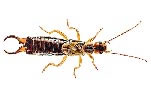
Common Pests – Earwigs
Description
The name “earwig” is derived from the anglo-saxon and would seem to reflect the belief that these insects would wriggle into the human ear. Earwigs are dark brown, with a thin, elongated body, roughly 10 to 14 mm long. They have fully developed wings but vary rarely fly.
Lifecycle and Habits
Earwigs mainly live outdoors where they can scavenge for food, but tend to come indoors for protection during the colder months. They are nocturnal creatures, hiding during the day in moist shady areas such as cracks and crevices, under doors and windows. They may also come indoors if the weather is hot and dry for a long time.
The female lays about thirty eggs in a covered cell in the soil during early spring. The eggs hatch after a few days and the mother remains with the eggs and later tends the first stage nymphs, brooding over them like a hen with chicks. After this stage the young scatter to lead an independent existence and after four to six nymphal stages they become adults. They live through the winter as either adults or eggs.
What Earwigs Eat
In their feeding habits the earwig is both carnivorous and vegetarian eating both small insects and plants. Some earwigs are predatory, feeding on aphids, insects and spiders. The primary function of their forcep-like ‘tail-end’ is uncertain – they may be used to capture insect prey and intimidate larger animals by their vicious appearance.
Problems Linked to Earwigs
In the garden earwigs have a reputation for damaging plants, but they do some good as well by preying on aphids, greenfly, etc. Indoors they are mainly just a nuisance, collecting in humid places like bathrooms, sometimes feeding and fouling on food. They are particularly troublesome in new housing estates, probably because they are dispossessed of their natural habitat by the building operations and possibly because suitable shelter is provided by buried rubble and building debris left in the vicinity of the new building.
Preventing or dealing with an infestation
Earwigs fly very reluctantly and they do not crawl very far either. They are very adept at being carried however, often hiding in folded newspapers, cut flowers or even luggage.
Earwigs may enter the house through the windows, so if you have long grass close to the building or climbing plants on the walls, cut these back. The cleared areas can then be treated with spray or dust insecticides, especially during damp weather. An effective chemical control can be achieved by applying residual insecticide barriers externally around the house, but efforts should be made to discover the principle harbourages and the routes used to invade the premises from the outside.
Pybuthrin Insect Powder is effective against earwigs and generous applications to the points of entry, doors, steps, window cills should be made.
Crawling Insect Killer aerosol is used for indoor treatment and should be applied to the areas frequented by the insects – porches, hallways, adjoining garages and other outbuildings.
Try to eliminate damp, moist conditions, often found in sub floor spaces and along house foundations, particularly by leaking gutters or drainpipes. Sealing gaps around doors, windows, pipes and other points of entry, proofing air vents with insect screening mesh, especially at the ground level, will prevent earwigs getting in your home. Changing the landscape around the house producing a clean, dry border around the foundation walls and using gravel or ornamental stones can make an attractive barrier against earwigs and other pest invaders.
If using insecticides, always follow the instructions.
Professional help
It may be advisable to contact a reputable Pest Control company, either for advice, or to carry out a professional treatment. The British Pest Control Association has a list of its member companies on its website, for all areas.